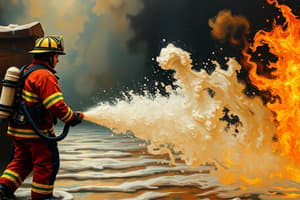Podcast
Questions and Answers
What is a foam proportioner?
What is a foam proportioner?
- The raw foam liquid in its storage container before being combined with water and air
- The mixture of foam concentrate and water before the introduction of air
- The completed product after air is introduced into the foam solution
- A device that injects the correct amount of foam concentrate into the water stream (correct)
What is required for mechanical foams to be ready for use?
What is required for mechanical foams to be ready for use?
- Pressurization and expansion
- Proportioning and aeration (correct)
- Separation and filtration
- Dilution and heating
What is foam concentrate?
What is foam concentrate?
- Completed product after air is introduced into the foam solution
- Mixture of foam concentrate and water before the introduction of air
- Foam solution
- Raw foam liquid in its storage container before being combined with water and air (correct)
What is foam solution?
What is foam solution?
When is foam considered as completed product?
When is foam considered as completed product?
How do class B foams suppress fires involving hydrocarbon fuels?
How do class B foams suppress fires involving hydrocarbon fuels?
What is the specific gravity of hydrocarbon fuels like crude oil and gasoline?
What is the specific gravity of hydrocarbon fuels like crude oil and gasoline?
What are polar solvent fuels known as?
What are polar solvent fuels known as?
What is the typical water concentration for firefighting foam concentrates?
What is the typical water concentration for firefighting foam concentrates?
What method of proportioning foam uses an external pump to force foam concentrate into the fire stream?
What method of proportioning foam uses an external pump to force foam concentrate into the fire stream?
What is the purpose of the premixing method of proportioning foam?
What is the purpose of the premixing method of proportioning foam?
How does foam extinguish and/or suppress vapors?
How does foam extinguish and/or suppress vapors?
What is the induction method of proportioning foam?
What is the induction method of proportioning foam?
What method is used when foam is poured directly into the tank?
What method is used when foam is poured directly into the tank?
What is the range of foam concentrate tank size for fire apparatus equipped with onboard foam proportioning systems?
What is the range of foam concentrate tank size for fire apparatus equipped with onboard foam proportioning systems?
How much foam may foam tenders carry for storage?
How much foam may foam tenders carry for storage?
How much foam is in a pail?
How much foam is in a pail?
How much foam is stored in barrels?
How much foam is stored in barrels?
How much foam is stored in totes?
How much foam is stored in totes?
What is the shelf life of properly stored foam solution?
What is the shelf life of properly stored foam solution?
At what percentage may class A foam concentrates be mixed for fire attack and overhaul with standard fog nozzles?
At what percentage may class A foam concentrates be mixed for fire attack and overhaul with standard fog nozzles?
What is the application rate in relation to the amount of foam solution applied to a fire?
What is the application rate in relation to the amount of foam solution applied to a fire?
What type of foam is suitable for areas requiring maximum penetration?
What type of foam is suitable for areas requiring maximum penetration?
What is the appropriate percentage range for proportioning class A foam for any application with air aspirating foam nozzles?
What is the appropriate percentage range for proportioning class A foam for any application with air aspirating foam nozzles?
What is the recommended percentage range for proportioning class A foam for any application with CAFS?
What is the recommended percentage range for proportioning class A foam for any application with CAFS?
What is the recommended shelf life for properly stored synthetic foam concentrate?
What is the recommended shelf life for properly stored synthetic foam concentrate?
What is the typical concentration range for Class B foams when used with polar solvents?
What is the typical concentration range for Class B foams when used with polar solvents?
What factors can affect foam expansion?
What factors can affect foam expansion?
What is the ratio range for medium expansion foam?
What is the ratio range for medium expansion foam?
How is the application rate available from a specific nozzle calculated?
How is the application rate available from a specific nozzle calculated?
What is the key feature of regular protein foam?
What is the key feature of regular protein foam?
What is the defining characteristic of fluoroprotein foam concentrate?
What is the defining characteristic of fluoroprotein foam concentrate?
Which type of foam concentrate is the most commonly used?
Which type of foam concentrate is the most commonly used?
What is the purpose of fluorochemical surfactants in foam solutions?
What is the purpose of fluorochemical surfactants in foam solutions?
What occurs when AFFF or FFFP is applied to hydrocarbon fuel fires?
What occurs when AFFF or FFFP is applied to hydrocarbon fuel fires?
At what concentration is Alcohol Resistant AFFF concentrate generally used?
At what concentration is Alcohol Resistant AFFF concentrate generally used?
What is the basic principle of foam proportioning devices?
What is the basic principle of foam proportioning devices?
What is the primary application of high expansion foam?
What is the primary application of high expansion foam?
What is the purpose of an in-line foam eductor?
What is the purpose of an in-line foam eductor?
What is the maximum pressure allowed at the discharge side of the eductor?
What is the maximum pressure allowed at the discharge side of the eductor?
What happens if the inlet pressure at the eductor is too high?
What happens if the inlet pressure at the eductor is too high?
The nozzle and eductor must have what to operate successfully?
The nozzle and eductor must have what to operate successfully?
What is the recommended inlet pressure range at the eductor for accurate blending of foam solution?
What is the recommended inlet pressure range at the eductor for accurate blending of foam solution?
What height above the foam concentrate should a foam eductor not exceed?
What height above the foam concentrate should a foam eductor not exceed?
What is the purpose of letting the eductor educt water for at least one minute?
What is the purpose of letting the eductor educt water for at least one minute?
What is a disadvantage of an around the pump proportioner?
What is a disadvantage of an around the pump proportioner?
Which type of foam proportioner is known for its accuracy in foam proportioning and ability to flow plain water and foam simultaneously?
Which type of foam proportioner is known for its accuracy in foam proportioning and ability to flow plain water and foam simultaneously?
What is a limiting factor of using CAFS (Compressed Air Foam System)?
What is a limiting factor of using CAFS (Compressed Air Foam System)?
What tactical advantage does CAFS offer in comparison to low energy systems?
What tactical advantage does CAFS offer in comparison to low energy systems?
What is the typical airflow rate of foam solution used in most structural and wildland operations with CAFS?
What is the typical airflow rate of foam solution used in most structural and wildland operations with CAFS?
How are smooth bore nozzles utilized in relation to foam usage?
How are smooth bore nozzles utilized in relation to foam usage?
What is the primary function of air aspirating foam nozzles?
What is the primary function of air aspirating foam nozzles?
Which method is used for class B application when a vertical surface is near or within a pool of ignitable liquid?
Which method is used for class B application when a vertical surface is near or within a pool of ignitable liquid?
How is the biodegradability of foam determined?
How is the biodegradability of foam determined?
What did studies by U.S. Forest Service reveal about class A foam in bodies of water?
What did studies by U.S. Forest Service reveal about class A foam in bodies of water?
What is the standard application ratio when using durable agents as an extinguishing agent?
What is the standard application ratio when using durable agents as an extinguishing agent?
What is the chemical composition of durable agents compared to class A foam?
What is the chemical composition of durable agents compared to class A foam?
For structure protection, what is the recommended application ratio for durable agents?
For structure protection, what is the recommended application ratio for durable agents?
Flashcards are hidden until you start studying
Study Notes
Foam Proportioning Overview
- A foam proportioner is a device used to mix foam concentrate with water to create foam solution for firefighting.
- Mechanical foams need water, foam concentrate, and air to be ready for use.
Foam Concentrates and Solutions
- Foam concentrate is a concentrated liquid that, when mixed with water, generates foam.
- Foam solution is the mixture of foam concentrate and water before it is dispensed.
Foam Completion and Fuel Types
- Foam is considered a completed product once the foam solution is properly mixed and ready for discharge.
- Class B foams effectively suppress fires involving hydrocarbon fuels by forming a barrier that prevents oxygen from reaching the fuel.
Specific Gravity and Fuel Classification
- Hydrocarbon fuels like crude oil and gasoline typically have a specific gravity of around 0.6 to 0.8.
- Polar solvent fuels are known as water-miscible fuels.
Concentration and Storage
- Typical water concentration for firefighting foam concentrates ranges from 3% to 6%.
- An external pump method of proportioning foam uses a pump to force foam concentrate into the fire stream.
Proportioning Methods
- Premixing method of proportioning foam mixes foam concentrate with water prior to application.
- Induction method involves drawing foam concentrate into the water stream using a venturi effect.
- Pouring foam directly into the tank is known as the pour-in method.
Foam Storage Capacities
- Foam concentrate tank sizes on fire apparatus can range from 20 to 500 gallons.
- Foam tenders can carry up to 1,000 gallons or more for storage.
- A pail typically contains 5 gallons of foam concentrate.
- Barrels usually hold 55 gallons of foam.
- Totes can store 275 gallons or more of foam.
Foam Solution Shelf Life and Application
- Properly stored foam solution has a shelf life of 10 years or more.
- Class A foam concentrates can typically be mixed at 0.1% to 1% for fire attack and overhaul with standard fog nozzles.
Application Rate and Types of Foam
- Application rate refers to the amount of foam solution applied per unit area of the fire.
- High expansion foam is suitable for maximum penetration in confined spaces.
- The appropriate percentage range for proportioning Class A foam with air aspirating nozzles is 0.1% to 1%.
Specific Foam Recommendations
- Recommended percentage range for Class A foam when using CAFS (Compressed Air Foam Systems) is typically 0.3% to 1%.
- Properly stored synthetic foam concentrate usually has a shelf life of around 10 years.
Class B Foam Concentrations
- Typical concentration range for Class B foams when used with polar solvents is 3% to 6%.
Foam Expansion Factors
- Factors affecting foam expansion include the type of proportioner, water quality, and concentrate formulation.
- Medium expansion foam typically has a ratio range of 10:1 to 100:1.
Application Calculations and Foam Types
- Application rate calculations from nozzles depend on flow rate and nozzle size.
- Regular protein foam features a protein base, while fluoroprotein foam concentrate contains additional fluorochemical additives.
Foam Behavior and Application Techniques
- AFFF (Aqueous Film Forming Foam) or FFFP (Film Forming Fluoroprotein) applied to hydrocarbon fires displaces oxygen and cools the fuel.
- Alcohol Resistant AFFF concentrate is generally used at a concentration of 3% to 6%.
Foam Proportioning Devices
- Foam proportioning devices work on the principle of mixing foam concentrate with water to achieve desired ratios.
- High expansion foam is primarily used in confined space situations to displace air.
- An in-line foam eductor allows for continuous mixing and application of foam solution.
Eductor Specifications
- Maximum pressure allowed at the discharge side of the eductor is typically around 100 psi.
- If inlet pressure is too high at the eductor, it may reduce foam effectiveness or damage the unit.
Eductor Requirements
- Successful operation of the nozzle and eductor requires proper matching of flow rates and pressures.
- Recommended inlet pressure range for accurate blending of foam solution is 50 to 70 psi.
- Height above the foam concentrate for the eductor should not exceed 10 feet to maintain suction.
Eductor Operation
- Letting the eductor educt water for one minute allows for proper priming and mixing of foam solution.
Proportioner Disadvantages and Advantages
- Around the pump proportioners may lead to inaccurate mixing ratios, especially at low flow rates.
- Accurate foam proportioners can flow plain water and foam simultaneously for effective dispensing.
CAFS Considerations
- A significant limiting factor of using CAFS is the need for a high airflow rate, which may require a larger apparatus.
- CAFS offers tactical advantages such as faster application rates and better coverage compared to low energy systems.
Structural and Wildfire Applications
- Typical airflow rates of foam solution with CAFS in structural and wildland operations can vary but are often around 20 to 40 CFM.
- Smooth bore nozzles are utilized to deliver a solid stream of foam solution effectively.
Nozzle Functions and Application Methods
- The primary function of air aspirating foam nozzles is to create an expanded foam through aeration.
- For class B foam applications, particularly near ignitable liquid pools, specific techniques must be used to mitigate the flames.
Foam Biodegradability and Environmental Considerations
- Biodegradability of foam is usually determined through laboratory testing and environmental impact assessments.
- Studies by the U.S. Forest Service indicated that Class A foam has minimal long-term environmental effects in bodies of water.
Durable Agents and Ratios
- The standard application ratio for durable agents as extinguishing agents typically ranges from 0.3:1 to 0.5:1.
- Durable agents have a chemical composition that differs from Class A foam, offering unique benefits for structure protection.
- For structure protection, the recommended application ratio for durable agents ranges from 0.5:1 to 1:1.
Studying That Suits You
Use AI to generate personalized quizzes and flashcards to suit your learning preferences.




